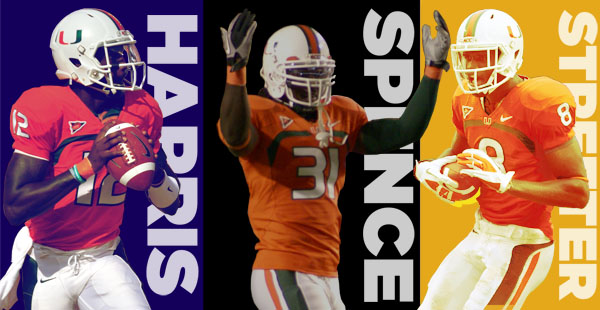
Seven football players came to the University of Miami from Miami Northwestern High School back in 2008. Among the top-ranked class of recruits hauled in by former head coach Randy Shannon are Jacory Harris, Sean Spence, Tommy Streeter, Brandon Washington, Marcus Robinson, Aldarius Johnson, Kendall Thompkins and Benjamin Jones.
Thompkins was the only player listed as less than a four-star recruit.
While the players will no longer suit up in orange and green, many of them are now looking to make their mark in the NFL. Spence, drafted by the Pittsburgh Steelers, was the ACC Defensive Freshman of the Year at linebacker, Streeter showed he has potential as a big-time NFL receiver and Harris climbed to second all-time in passing touchdowns among UM’s storied quarterbacks. But of course, the story is not that simple.
The decision for these players to come to Miami as a package deal was far from a sure thing. Most notable was the case of Harris and Streeter, both recruited heavily by the University of Oregon; they each took an official visit to the Eugene campus. They were met with a newly-renovated program funded almost entirely by Nike money, as the company’s co-founder, Phil Knight, became the school’s largest athletic booster and showered the program with the newest training equipment, facilities and jerseys.
“I thought Jacory and Streeter were gonna go to Oregon because of their offensive system,” Washington said. “Those guys took a visit there and when they came back that was all they talked about – Oregon this and Oregon that. So I was like, ‘Was the colors gonna get y’all? Was the uniform gonna get y’all?’”
Fortunately for Miami, they did not. Harris and Streeter returned from Oregon for good, instead deciding to sign with the Hurricanes and embark on a college football career with extraordinary expectations.
“First of all, Oregon is like 9,000 miles away and our family wouldn’t be able to see us,” Harris said. “When we took the trip out there, it took three flights before we made it. I wouldn’t want our parents to go through the same things, so we wanted to stay home and play in front of our family.”
Streeter also considered family an important factor in his decision.
“When times get hard, I have people I can depend on to cheer me up,” said Streeter, who struggled early in his career with injuries and inconsistent production. “Even just going home to get home-cooked meals, just hanging out and being at ease. That’s something that would be lacking if I didn’t come here.”
And what was the big draw about this city? Much maligned for being fair-weather, particularly when the weather is fair, the notoriously fickle Miami fan base wouldn’t match the deafening roars in Eugene or Chapel Hill. For Harris, it wasn’t about playing for South Beach or the Gables, but the chance to play for and in front of his city, his home and his community.
“The connection to our community is pretty strong,” Harris said. “I wouldn’t say the city. [It’s] the black community, to be honest. That’s our connection, through them, where we grew up in the inner city. That’s strong. They always support us no matter what.”
Harris stated that he always receives support.
“Through hard times or good times … [the community] is our foundation. They look at us like we’re Obama or something,” Harris said. “They don’t treat us quite like that, but that’s how they view us.





